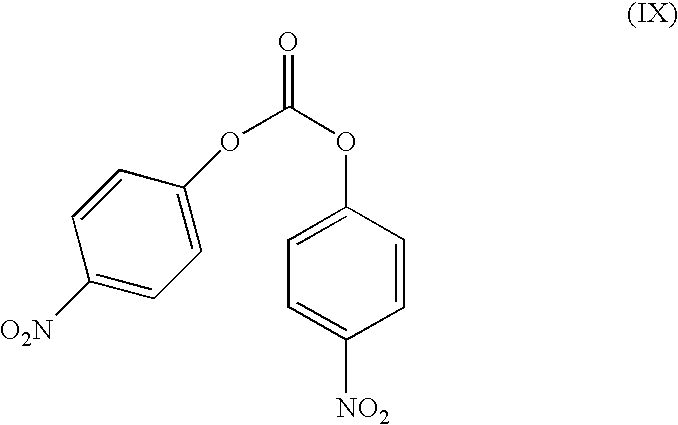Process for making aminoalkylphenyl carbamates and intermediates therefor
a technology of aminoalkylphenyl carbamate and aminoalkylphenyl phenyl, which is applied in the preparation of carbamic acid derivatives, organic compound preparation, organic chemistry, etc., can solve the problems of high temperature and long reaction time of reaction using compound (v), and achieve long reaction time and high temperature
- Summary
- Abstract
- Description
- Claims
- Application Information
AI Technical Summary
Problems solved by technology
Method used
Image
Examples
example 1
Synthesis and Isolation of Compound VII-1a without Using (IX)
[0070]
[0071]1 g 3-(1-Dimethylamino)ethyl) phenol was dissolved in 20 ml dichloromethane (dried on CaCl2). The solution was cooled to −78° C. 0.92 g triethylamine was added. A solution of 1.22 g 4-nitrophenyl chloroformate in 5 ml dichloromethane (dried on CaCl2) was added dropwise over 5 minutes. The mixture was stirred at −78° C. Reaction progress was monitored with HPLC. After 3 hours at −78° C., the reaction mixture was allowed to warm to ambient temperature and was then washed with 2×20 ml water, dried (Na2SO4), filtered and concentrated in vacuo.
[0072]
Isolated yield:2.1 g, yellow oilHPLC:83% purity1H- and 13C-NMR:confirmed the expected structure
example 2
Synthesis and Isolation of the Compound (VII-1b) Using (IX)
Reaction Scheme:
[0073]
[0074]0.5 g (S)-3-(1-(Dimethylamino)ethyl) phenol was dissolved (not completely) in 10 ml dichloromethane (distilled from CaCl2). 1.1 g bis(4-nitrophenyl)carbonate was added. The yellow solution was stirred at ambient temperature. Reaction progress was monitored with HPLC. The reaction mixture was concentrated in vacuo. To the resulting yellow oil, 20 ml diethyl ether and 20 ml of a solution of hydrochloric acid (2 M) were added. The 2-phase system was stirred for 15 minutes. The acidic aqueous layer was washed with 20 ml diethyl ether.
[0075]20 ml dichloromethane was added to the aqueous layer and a solution of sodium hydroxide (2 M) was added until pH˜12 was reached. The organic layer was washed with 2×20 ml water, dried (Na2SO4), filtered and concentrated in vacuo.
[0076]
Isolated yield:0.57 g (57%), yellow oilHPLC:84.2% purity
example 3
Synthesis of Rivastigmine from the Compound (VII-1b)
Reaction Scheme:
[0077]
[0078]0.32 g Crude carbonate compound from Example 2 was dissolved in 5 ml dichloromethane (distilled from CaCl2). 86 mg N-Ethylmethylamine was added dropwise. The yellow solution was stirred at ambient temperature. Reaction progress was monitored with HPLC.
[0079]After 3 hours, the reaction mixture was concentrated in vacuo. To the resulting yellow oil, 20 ml diethyl ether and 20 ml of a solution of hydrochloric acid (2 M) were added. The 2-phase system was stirred for 15 minutes. The acidic aqueous layer was washed with 20 ml diethyl ether.
[0080]20 ml dichloromethane was added to the aqueous layer and a solution of sodium hydroxide (2 M) was added until pH˜12 was reached. The organic layer was washed with 2×20 ml water, dried (Na2SO4), filtered and concentrated in vacuo.
[0081]
Isolated yield:0.15 g (62%), yellow oilHPLC:96.9% purity; 99.1% e.e.
PUM
| Property | Measurement | Unit |
|---|---|---|
| temperature | aaaaa | aaaaa |
| temperature | aaaaa | aaaaa |
| reaction temperature | aaaaa | aaaaa |
Abstract
Description
Claims
Application Information
 Login to View More
Login to View More - R&D
- Intellectual Property
- Life Sciences
- Materials
- Tech Scout
- Unparalleled Data Quality
- Higher Quality Content
- 60% Fewer Hallucinations
Browse by: Latest US Patents, China's latest patents, Technical Efficacy Thesaurus, Application Domain, Technology Topic, Popular Technical Reports.
© 2025 PatSnap. All rights reserved.Legal|Privacy policy|Modern Slavery Act Transparency Statement|Sitemap|About US| Contact US: help@patsnap.com



